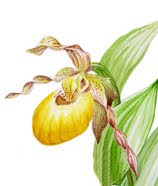Orchids, to me, are sort of the plant kingdom parallel to humans - they're adaptable, vulnerable, beautiful, long-lived (sometimes), and have a long "infancy" - that is to say the period before they are fully able to be self-sustaining. Orchids are fairly old as far as flowering plants go, and we can tell that because they have developed so many different forms, because they are present on every continent except Antarctica, and they have more chromosomes than humans do, in some cases! They are very vulnerable to the water cycle, as is all life, tho there are some orchids which live in very dry climates. Some live inside the Arctic circle, and others live in the southern part of Tasmania, just next to the Antarctic circle! When orchids are not just being completely bizarre, they are fascinating, beautiful, addictive to many collectors and rare plant fanciers. They can live for many many years - I had one that lived over twenty years with me (and was probably ten years old when I was given it as a gift), and a year of neglect while I was juggling school, parenthood, work and many other things, finally brought its health to an end, and I lost it. : (
Orchids start life as a very very tiny seed. If you remember your basic fourth-grade botany lesson, all seeds contain an embryo (which develops into the growing plant), a seed coat to protect the embryo until it sprouts, and endosperm, to feed the embryo while it reaches up to the sky and down to find some anchoring place and set roots. Right? Uh, not in the case of orchids! Oops! No food! The poor things are sent on their way in a papery seed coat, with no food. The little orphan, with its zillion brother/sister seeds from the same capsule (that is to say if there are any pollinators left in town!) are sent across the air currents to find a hospitable place that has - what? Fungus??? Right. The embryo develops a relationship with a fungus which, if it doesn't kill it outright, feeds it (by borrowing sugars and starches from other plants it's attached to already) in the hope of getting some food itself once the plant is big enough to share some. A web of life, indeed! Everything's all connected by the fungus in this ecological chain!
The embryo turns into something called a protocorm with the help of this fungus (and different orchid species need different fungi, too). It takes a loooonnnnnng time for this to happen! A year or more sometimes! Finally, the protocorm develops something looking like leaves and roots, and the little plant is on its way. But it takes years - several years! In the case of north American terrestrial (that means living with its roots in the ground) orchids, up to fifteen years before you see flowers!
If you dig up an orchid to take it home and plant it in your yard, you've killed it. You just removed its food source. A single orchid plant needs a web of fungus at least an acre in size to grow and bloom. If you dig up the plant, it's like cutting off its roots. That's bad. Then that ecosystem, which probably didn't have a lot of orchids to begin with, just lost a lot of good genetic material - so we just lost diversity. That's bad too! Diversity is good. So moral - don't dig up orchids. That's just mean.
Wednesday, January 10, 2007
Subscribe to:
Post Comments (Atom)


No comments:
Post a Comment